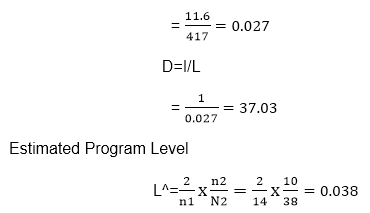Halstead's Software MetricsAccording to Halstead's "A computer program is an implementation of an algorithm considered to be a collection of tokens which can be classified as either operators or operand." Token CountIn these metrics, a computer program is considered to be a collection of tokens, which may be classified as either operators or operands. All software science metrics can be defined in terms of these basic symbols. These symbols are called as a token. The basic measures are n1 = count of unique operators. In terms of the total tokens used, the size of the program can be expressed as N = N1 + N2. Halstead metrics are:Program Volume (V) The unit of measurement of volume is the standard unit for size "bits." It is the actual size of a program if a uniform binary encoding for the vocabulary is used. V=N*log2n Program Level (L) The value of L ranges between zero and one, with L=1 representing a program written at the highest possible level (i.e., with minimum size). L=V*/V Program Difficulty The difficulty level or error-proneness (D) of the program is proportional to the number of the unique operator in the program. D= (n1/2) * (N2/n2) Programming Effort (E) The unit of measurement of E is elementary mental discriminations. E=V/L=D*V Estimated Program Length According to Halstead, The first Hypothesis of software science is that the length of a well-structured program is a function only of the number of unique operators and operands. N=N1+N2 And estimated program length is denoted by N^ N^ = n1log2n1 + n2log2n2 The following alternate expressions have been published to estimate program length:
Potential Minimum Volume The potential minimum volume V* is defined as the volume of the most short program in which a problem can be coded. V* = (2 + n2*) * log2 (2 + n2*) Here, n2* is the count of unique input and output parameters Size of Vocabulary (n) The size of the vocabulary of a program, which consists of the number of unique tokens used to build a program, is defined as: n=n1+n2 where n=vocabulary of a program Language Level - Shows the algorithm implementation program language level. The same algorithm demands additional effort if it is written in a low-level program language. For example, it is easier to program in Pascal than in Assembler. L' = V / D / Dlambda = L * V* = L2 * V Language levels
Counting rules for C language
Example: Consider the sorting program as shown in fig: List out the operators and operands and also calculate the value of software science measure like n, N, V, E, λ ,etc. Solution: The list of operators and operands is given in the table
Here N1=53 and N2=38. The program length N=N1+N2=53+38=91 Vocabulary of the program n=n1+n2=14+10=24 Volume V= N * log2N=91 x log2 24=417 bits. The estimate program length N of the program = 14 log214+10 log2)10 Conceptually unique input and output parameters are represented by n2*. n2*=3 {x: array holding the integer to be sorted. This is used as both input and output} {N: the size of the array to be sorted} The Potential Volume V*=5log25=11.6 Since L=V*/V 
We may use another formula V^=V x L^= 417 x 0.038=15.67E^=V/L^=D^ x V 
Therefore, 10974 elementary mental discrimination is required to construct the program. 
This is probably a reasonable time to produce the program, which is very simple.
Next TopicFunctional Point (FP) Analysis
|
 For Videos Join Our Youtube Channel: Join Now
For Videos Join Our Youtube Channel: Join Now
Feedback
- Send your Feedback to [email protected]
Help Others, Please Share









